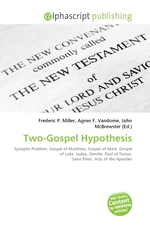Two-Gospel Hypothesis
Frederic P. Miller, Agnes F. Vandome, John McBrewster
бумажная книга
Please note that the content of this book primarily consists of articles available from Wikipedia or other free sources online. The Two-Gospel Hypothesis is a proposed solution to the Synoptic Problem. The hypothesis, (once called the Griesbach hypothesis), was introduced in its current form by William Farmer in 1964. The synoptic problem concerns the pattern of similarities and differences between the three Gospels of Matthew, Mark, and Luke. The hypothesis states that Matthew was written first, while Christianity was still confined to Judea, to calm the hostility between Jews and Christians. After Matthew, as the church expanded beyond the Jewish world, Luke was written as a gospel to the Gentiles. But since neither Luke (nor his patron Paul) were eyewitnesses of Jesus, Peter gave public testimonies that validated Luke’s gospel. These public speeches were transcribed into Mark’s gospel and distributed immediately thereafter, as recorded by the early church father Irenaeus. Paul then allowed Luke’s gospel to be published. This hypothesis is the most serious alternative to the two-source hypothesis.
Данное издание не является оригинальным. Книга печатается по технологии принт-он-деманд после получения заказа.


